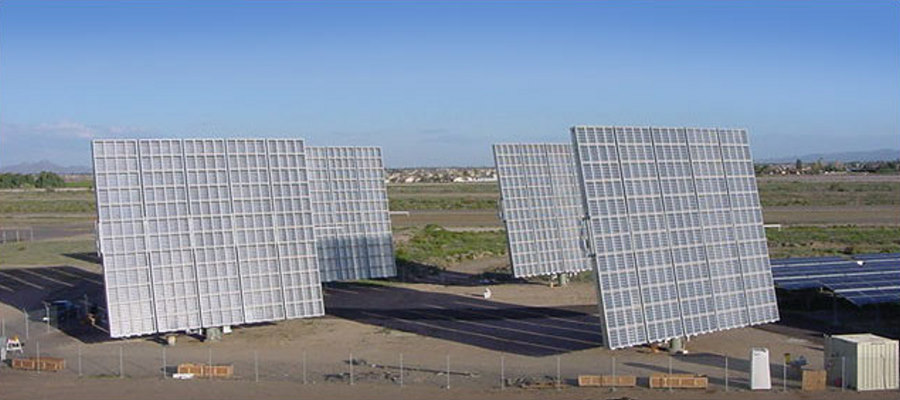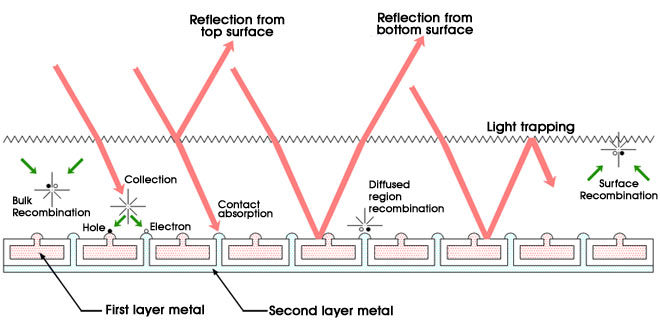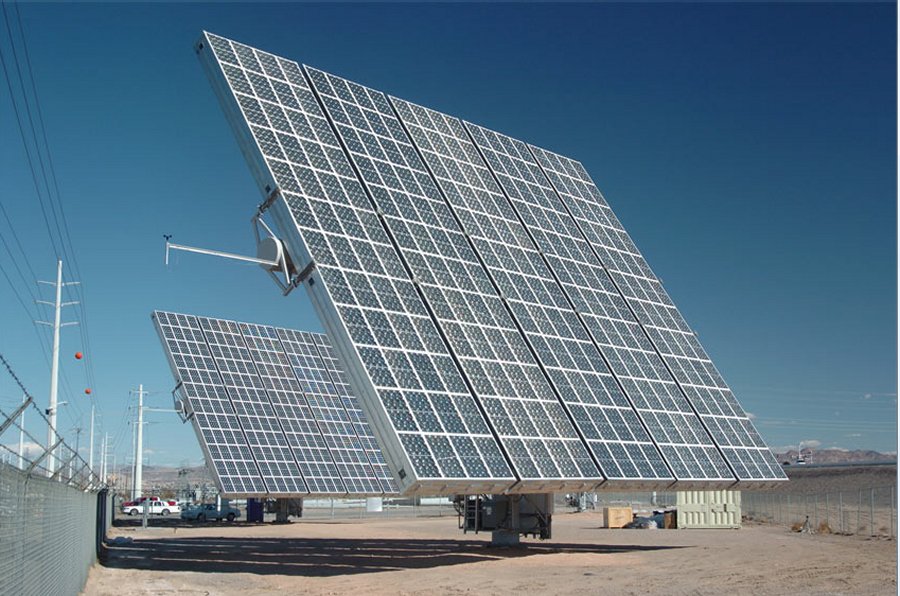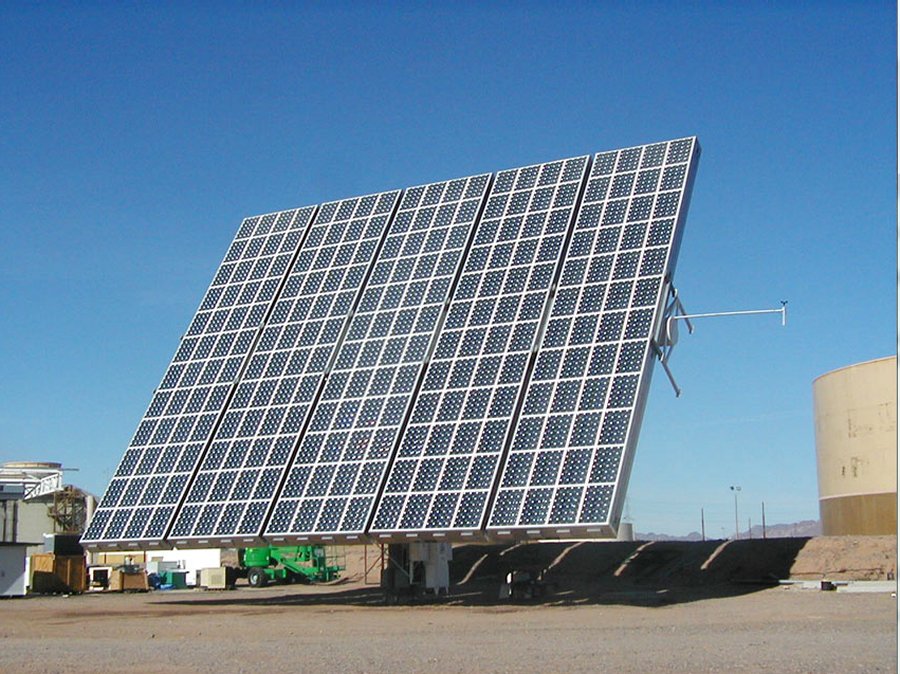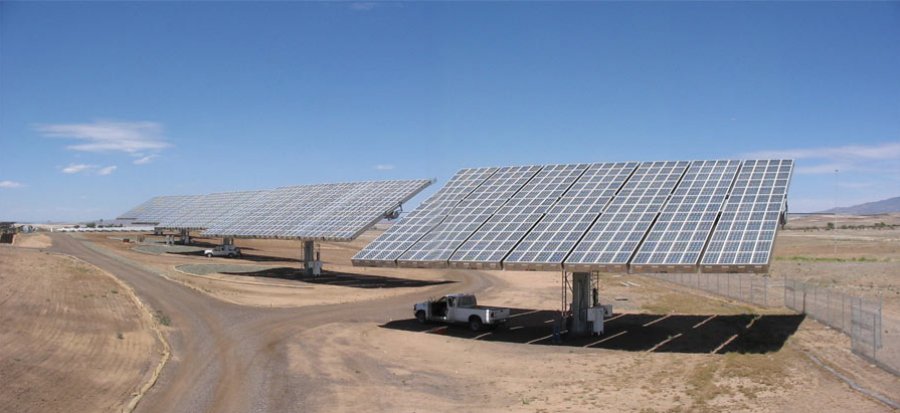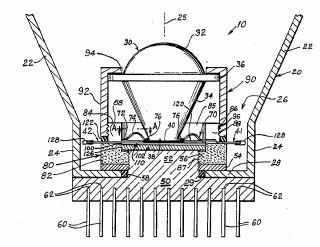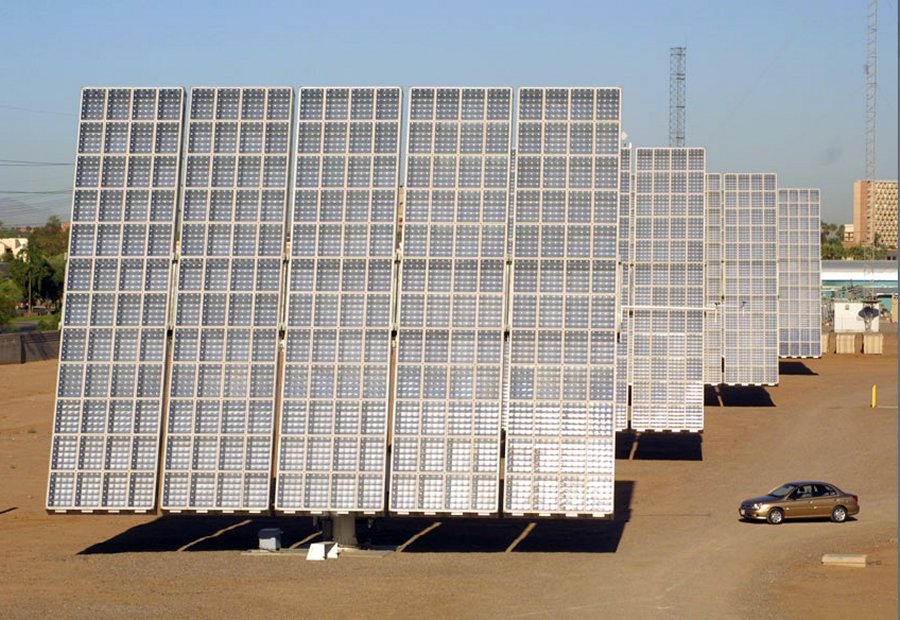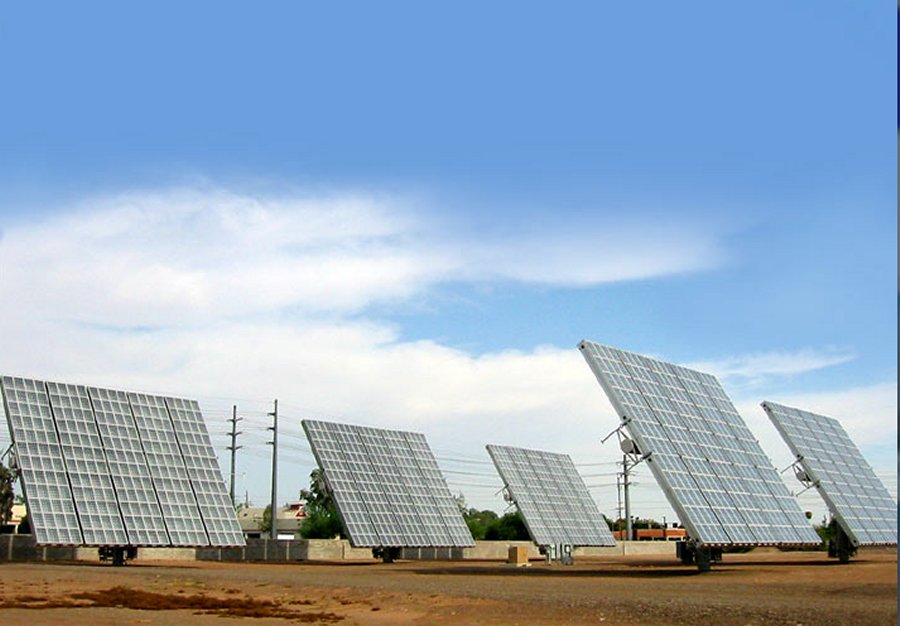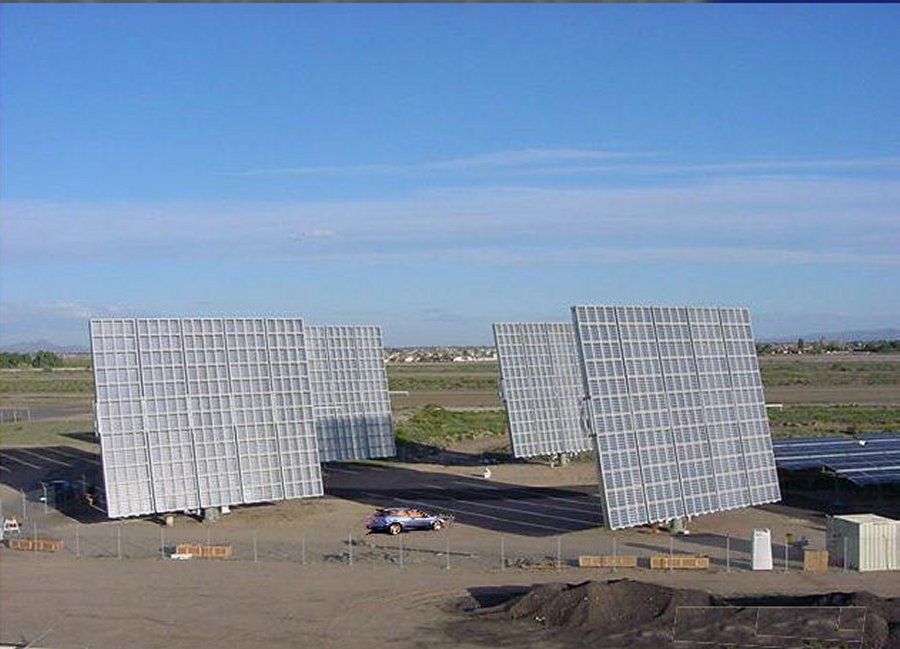|
Solar Power |
||
|
Solar Power Collectors
Amonix is the world leading designer and proprietary manufacturer of patented high-performance High Concentration Photovoltaic (HCPV) power generation systems for utility scale applications. Amonix is located in Torrance, California, just minutes from LAX and the Port of Los Angeles. The Amonix mission is to bring solar profitably to the main stream in the power generation market by offering renewable solar power at a fraction of the cost of traditional photovoltaic systems. The Amonix product is a fully integrated two-axis tracking system that promises to lower the cost of solar electricity compared to conventional one-sun solar systems. Amonix’s concentrating solar technology leverages billions of dollars that have been invested in the microelectronics industry by enabling the company to manufacture its high-efficiency solar cell at existing microelectronic chip manufacturing foundries. Not only does this save money, but it also allows manufacturing to be ramped up quickly without tens of millions of dollars of investment. Amonix’s HCPV system tracks the sun, capturing up to 25 – 30% more energy than fixed photovoltaic systems, and operates during periods of peak power demand. The company’s extensive field experience has produced a reliable 5th generation commercial system designed to meet or exceed stringent customer requirements for a minimum 20 year life span. These systems can be installed individually or can be readily combined to form multi-megawatt “power farms”. They can also be used off-grid in a variety of applications including village electrification, water pumping, water desalinzation, and Hydrogen production. Amonix’s 5th generation system has been extensively field-proven by Arizona Public Service Company, Arizona’s largest electric utility, and is ready for deployment. Although there are many and varied applications for Amonix’s systems, the company will initially focus on the large power producers in the Southwestern United States. In these areas there is a high level of direct sunlight that maximizes the cost advantages of the Amonix system. In addition, the state utilities in this area have mandated a minimum requirement for solar energy production as part of their energy portfolios. Amonix is continually implementing design improvements to its current system that will reduce manufacturing costs without impacting system reliability or performance. The experience Amonix has gained, along with several patents and intellectual property rights, has positioned the company as an undisputed leader in the concentrating photovoltaic arena. SOURCE: AMONIX HOME PAGE |
||
|
..
Silicon, because of its abundant nature (sand) and widespread use in the manufacture of semiconductor devices such as computer chips, quickly became the material of choice for solar cells. Over the last several decades, crystalline silicon solar cell technology has become the “workhorse” technology for the majority of PV applications. However, despite its good performance and well-understood manufacturing processes, traditional crystalline silicon solar cell technology remains costly. Subsequently, traditional flat-plate PV systems, which one can see on many rooftops, parking structures, and other facilities, remain costly as well. The industry's design focus has been to reduce the PV system cost "culprit"--the silicon solar cell. Most approaches strive to reduce the silicon material content, many of which involve reducing the thickness of the cells themselves by using very thin films (like paints) of the material. Amonix, because of its extensive background in high-tech semiconductor design and manufacturing, pursued a highly cost-effective approach which involves reducing the area of cell material required to generate a given amount of electricity. This is the high-concentration concept. Amonix has been successful in reducing the silicon cell area by over 500 times with its High-Concentration Photovoltaic (HCPV) system and MegaModule™ design. The Cell The concept of concentrating sunlight onto a solar cell had been studied for many years; however, one of its main obstacles was that solar cells became very inefficient when exposed to the extreme conditions associated with concentrated sunlight. In 1989, the Electric Power Research Institute (EPRI), the research arm for several hundred domestic utility companies, approached Amonix to solve the solar cell stabilization problem. Using its extensive semiconductor background, Amonix was successful at stabilizing a highly efficient silicon solar cell. Further efforts led to the development of a back-junction point-contact silicon solar cell which is the cornerstone of Amonix's HCPV system. This cell has many superior design attributes including the following:
Concentration
In order to optimize performance, concentrating systems must track the sun to absorb its direct normal light (DNI). Amonix has developed a proprietary hydraulically-driven tracker to accomplish this. Because Amonix's systems actively track the sun to concentrate sunlight onto the cell, they maximize energy production throughout the day. Field results indicate that approximately 30% more energy is captured by Amonix's systems than with fixed, one-sun systems. Amonix’s effective implementation of concentration and tracking offers customers the possibility of the lowest levelized cost (cents/kWh) of any solar generated electricity. SOURCE: AMONIX TECHNOLOGY |
||
|
Solar Power Installations Nevada Power Company site in Las Vegas
Amonix is currently manufacturing and installing three 25 kW units for Nevada Power Company in Las Vegas. The site is located at the Nevada Power Clark Generating Station in the Southeast part of Las Vegas. Installation of foundations, pedestals, and drive systems are now complete as shown in Figure 13. The MegaModules are now being manufactured with a new receiver plate design. The installation will be operational in the March time frame.
|
||
|
Solar Power Installations University of Nevada in Las Vegas Site
One Amonix 25 kW unit was installed at the Center for Energy Research at the University of Nevada in Las Vegas in March of 2004. This project is a joint effort by UNLV, Amonix, and Arizona Public Service under the direction of Mary Jane Hale of the National Renewable Energy Laboratory (NREL) and funded by the Nevada Southwest Energy Partnership. This unit, shown is being operated by the students to obtain energy and reliability performance data. Simultaneously, the students are learning about the technology. This system started operating in late March 2004 and has generated over 90 MWh since that time. |
||
|
Solar Power Instalations Prescott Arizona APS Site
APS is currently constructing a concentrating PV plant near Prescott, Arizona. There are five 35 kW units in operation at this site. The first 35 kW unit began operating in late 2002. Four additional 35 kW units were installed in 2003, for a present total of 140 kW. Figure 11 shows the five systems in operation. These five Amonix units have generated over 590 MWh of grid power. |
||
|
Liquid-cooled sealed enclosure for concentrator solar cell and secondary lens
Publication number: US4830678
The sealed enclosure for an electrical power generation solar concentrator holds and protects the photovoltaic cell from ambient conditions and thermal shock, while multiple fingers of front and rear electrical contact terminals accommodate thermal expansion and contraction of the cell and minimize mechanical stresses on the cell. This sealed enclosure also holds the secondary lens and protects the internally reflective truncated conical rear surface of the lens. A base member has a socket for receiving the cell and its associated front and rear terminal members together with an insulator alignment disc having an opening receiving the cell and for aligning the cell with the axis of the concentrator. A front housing removably screws onto the base member with an inturned front lip gripping a peripheral flange on the secondary lens, thereby aligning it with the cell and firmly pressing it against the cell front for causing thermal mass and inertial of the lens to moderate temperature changes in the cell. The base member screws onto a pedestal of a finned heat sink of good thermal conductivity fitting into a pre-punched hole in a panel of the concentrator, thus aligning the sealed enclosure with the concentrator axis. The pressure of the secondary lens on the cell causes the cell back to press onto its multiple-fingered rear contact member of good electrical and thermal conductivity which in turn is pressing against a thin electrical insulator in good thermal conductivity with the heat sink pedestal. |
||
|
Solar Power Installations APS STAR Center, West Field Site
There are currently 145 kW in operation in the West field at the APS STAR facility in Tempe, Arizona. The field now consists of three 25 kW units and two 35 kW units. Initially there were three 20 kW units and three 25 kW units as shown in Figure 8. The MegaModules from the three 20 kW units were moved to a new 35 kW drive system. These units were installed during the period from 2000 to 2003 and represent different versions and configurations as the design matured. The 35 kW units, incorporating 7 MegaModules, are the latest design to be manufactured and installed at this site. The units in the west field have produced over 1,185 MWh of grid power since the start of operation. |
||
|
Solar Power Installations APS STAR Center, East Field Site
A second field of Amonix units is located on the east side of the APS STAR facility (see Figure 9). There are five 25 kW units, for a total of 125 kW, at this location. These units were installed during 2002 and have generated over 832 MWh of grid power. |
||
|
Solar Power Installations Glendale Arizona APS Site
Units were installed in Glendale, Arizona (near Phoenix, AZ) during the first half of 2001. This site is located at the southwest corner of the Glendale airport. It consists of four 25 kW units, for a total of 100 kW as shown in Figure 10. Since installation, this site has produced over 626 MWh of grid power. There are no operating or maintenance personnel located at this site. The daily performance is remotely monitored from the APS STAR facility. When there is a problem, a maintenance person is sent out from the STAR facility. |
||
| FAIR USE NOTICE: This page contains copyrighted material the use of which has not been specifically authorized by the copyright owner. Pegasus Research Consortium distributes this material without profit to those who have expressed a prior interest in receiving the included information for research and educational purposes. We believe this constitutes a fair use of any such copyrighted material as provided for in 17 U.S.C § 107. If you wish to use copyrighted material from this site for purposes of your own that go beyond fair use, you must obtain permission from the copyright owner. | ||
|
|
